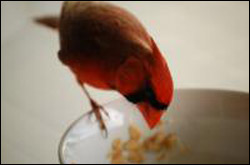Birdsong sounds sweeter because throats filter out messy overtones

Northern Cardinals actively change the volume and shapes of their throats as they sing.
"We show that songbirds adjust the size and shape of their vocal tract to ’fit’ the changing frequency of their song," IU neurobiologist Roderick Suthers said. "This enables the bird to produce a more whistle-like, pure-tone song."
The finding supports a growing consensus that birds and humans make sound in much the same way — although it is presumed these processes evolved independently of each other in birds and hominids. In 2004, Suthers reported in the journal Current Biology that monk parakeets use their tongues to shape sound. Other studies have implicated beaks, especially beak gape, in shaping the sound that birds produce. Similarly, humans move their tongues, alter the shape of their upper vocal tracts, and change the shape of their mouths when they sing, laugh, talk and groan.
"The bird’s vocal tract, like the human vocal tract in speech, acts as a resonance filter that can control the sound coming from the mouth," Suthers said. "Beak movements during song also contribute to this filter, but are not as important as changes in the size of the internal vocal tract. Human sopranos use the same technique as the cardinal to increase the loudness of very high notes so they can be heard above the orchestra."
That birds’ throats vibrate when they sing will come as no surprise to birdwatchers. The effect of these oscillations on the birds’ sound production, however, was unknown.
The acoustics of sound-making are complicated. Most tones produced in nature are accompanied by a complex series of higher-pitched, quieter tones called overtones. When the loudness of these overtones is high, the tone sounds more complex. Birds can control the loudness of overtones to increase the tonal purity of their song. Humans use a similar technique to produce different vowel sounds of speech by altering the shapes of their throats, the positions of their tongues and the wideness of their mouths. The PNAS study reveals yet another parallel between birdsong production and human speech.
"At low frequencies, the bird increases the volume of its oropharyngeal cavity and even expands the top of its esophagus," Suthers said. "These air-filled structures form a single cavity with a resonant frequency that matches the main frequency of the song. This amplifies the fundamental frequency and suppresses overtones."
Suthers, biologist Tobias Riede, who is now at the National Center for Voice and Speech (Colorado), Purdue University veterinary scientist William Blevins, and Australian National University acoustic physicist Neville Fletcher used X-ray cinematography to observe and measure the shape and total volume (three-dimensional space, not loudness) of a cardinal’s throat as it spontaneously sang. Explanatory video can be downloaded here:
www.iuinfo.indiana.edu/bem/mr/rsfb/north_cardinal_large.mov (10 megs)
www.iuinfo.indiana.edu/bem/mr/rsfb/north_cardinal_small.mov (4 megs)
(Modeling and animation by Eric Wernert, IU University Information Technology Services Advanced Visualization Lab)
The scientists determined that note changes in birdsong are accompanied by controlled changes in the volume of the upper esophagus as well as the positions of the bird’s larynx and hyoid skeleton (a U-shaped bone formation in the bird’s throat). They also found that the volume of the upper esophagus goes up whenever the main tone produced by the bird goes down, and vice versa. These alterations of shape have the effect of increasing the main tone and suppressing the loudness of overtones.
Media Contact
More Information:
http://www.indiana.eduAll latest news from the category: Life Sciences and Chemistry
Articles and reports from the Life Sciences and chemistry area deal with applied and basic research into modern biology, chemistry and human medicine.
Valuable information can be found on a range of life sciences fields including bacteriology, biochemistry, bionics, bioinformatics, biophysics, biotechnology, genetics, geobotany, human biology, marine biology, microbiology, molecular biology, cellular biology, zoology, bioinorganic chemistry, microchemistry and environmental chemistry.
Newest articles

Bringing bio-inspired robots to life
Nebraska researcher Eric Markvicka gets NSF CAREER Award to pursue manufacture of novel materials for soft robotics and stretchable electronics. Engineers are increasingly eager to develop robots that mimic the…

Bella moths use poison to attract mates
Scientists are closer to finding out how. Pyrrolizidine alkaloids are as bitter and toxic as they are hard to pronounce. They’re produced by several different types of plants and are…

AI tool creates ‘synthetic’ images of cells
…for enhanced microscopy analysis. Observing individual cells through microscopes can reveal a range of important cell biological phenomena that frequently play a role in human diseases, but the process of…





















